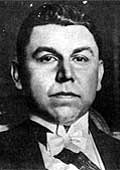 |
Felipe Adolfo de la Huerta Marcorb. 26 May (or early Oct) 1881, Hermosillo (or Guaymas), Sonora |
| Title: | Jefe Supremo Interino del Ejército Liberal Constitucionalista (Interim Supreme Chief of the Constitutionalist Liberal Army) |
| Term: | 23 Apr 1920 - 1 Jun 1920 |
| Chronology: | 23 Apr 1920, appointed by revolutionary proclamation, Plan Orgánico del Movimiento Reivindicador de la Democracia y de la Ley (Plan de Agua Prieta), Art. 7, issued at Agua Prieta, Sonora |
| 1 Jun 1920, ceased to serve as Jefe Supremo Interino del Ejército Liberal Constitucionalista being sworn in as Constitutional President-Substitute of the Mexican United States; provision set up in the Plan de Agua Prieta | |
| Title: | Presidente Constitucional Substituto de los Estados Unidos Mexicanos (Constitutional President-Substitute of the Mexican United States) |
| Term: | 1 Jun 1920 - 30 Nov 1920 |
| Chronology: | 24 May 1920, elected by the Electoral College constituted by the members of the Congreso de la Unión (Congress of the Union), session of the Congress, Salón de Sesiones de la Cámara de Diputados, Mexico City [1][2] |
| 1 Jun 1920, sworn in, joint session of the twenty-eighth Congress of the Union, salón de Sesiones de la Cámara de Diputados, Mexico City [3] | |
| 30 Nov 1920, expiration of term [2] |
| Biography: | |||||||||||
Educated at the Colegio de Sonora, Hermosillo, and at the Escuela Nacional Preparatoria (National Preparatory School), Mexico City; studied accounting, music, and singing; returned to Sonora, where worked as bookkeeper, bank employee, tannery manager and singing-master; was affiliated (from 1908) with the Partido Nacional Antirreeleccionista (Anti-Reelectionist Party); left Guaymas to become involved in politics in central Mexico; supported political campaigns of Francisco Madero; negotiated peace terms with the Yaqui Indians in Sonora; was elected a deputy (1911-1913) to the Congreso del Estado de Sonora (Congress of the State of Sonora); joined Venustiano Carranza and the Constitutionalist Army during the Revolution; appointed senior official of the Administration of Government (1913); appointed provisional governor of Sonora (19 May 1916 - 18 Jun 1917); elected to the federal Senado (1917); served as consul general in New York, U.S. (1917-1918); elected governor of the State of Sonora (served 1 Sep 1919 - 1 Sep 1923); joined the rebellion against Carranza initiated by Plutarco Elías Calles, Ángel Flores, Francisco R. Manzo and other military leaders; in accordance with the Plan de Agua Prieta (23 Apr 1920), appointed Supreme Head of the Constitutionalist Liberal Army; entered Mexico City, forcing Carranza to flee the capital; following the assassination of Carranza, was elected President Substitute of the Mexican United States (1 Jun 1920 - 30 Nov 1920); served as finance minister (1 Dec 1920 - 25 Sep 1923); launched a rebellion (1923-1924) against the government of Álvaro Obregón; fled to the United States and lived in Los Angeles, California; was invited to return to Mexico by Lázaro Cárdenas (1935); held a number of minor government positions. Biography source: [4] |
|||||||||||
| Elections: | |||||||||||
|
|||||||||||
| | |||||||||||
| [1] | Diario de los Debates de la Cámara de Diputados del Congreso de los Estados Unidos Mexicanos - Año II - Período Extraordinario XXVIII Legislatura - Tomo IV - Número 6. | ||||||||||
| [2] | The election of president was held according to Art. 11 of the Plan de Agua Prieta. The length of his term was fixed by resolution (24 May 1920) of the Congress as lasting from 1 Jun 1920 to 30 Nov 1920. | ||||||||||
| [3] | Diario de los Debates de la Cámara de Diputados del Congreso de los Estados Unidos Mexicanos - Año II - Período Extraordinario XXVIII Legislatura - Tomo IV - Número 8. | ||||||||||
| [4] | "Adolfo de la Huerta: La integridad como arma de la Revolución", by Pedro Fernando Castro Martínez (Siglo XXI, 1998). | ||||||||||
